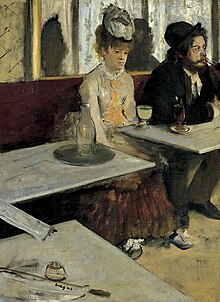The plum (Manet)

|
| The plum |
|---|
| Édouard Manet , around 1878 |
| Oil on canvas |
| 73.6 x 50.2 cm |
| National Gallery of Art |
The plum (French: La Prune) is a picture by the painter Édouard Manet . It was created around 1878 and shows a young woman at a table in the Café de la Nouvelle Athènes . The model is assumed to be Ellen Andrée , who had already sat the model for Edgar Degas ' painting The Absinthe - together with Marcellin Desboutin .
description
A young woman is sitting behind a marbled table. She holds her upper body slightly bent forward and rests her head on the back of her right hand. The left hand lies limply on the table, holding a cigarette between the middle and index fingers that has not yet been lit. In front of the woman is a glass goblet that contains a brown plum. The woman's gaze floats dreamily to the left out of the picture, as if it were not capturing anything that aroused his interest. Her features appear tired and relaxed, as if she's had a hard day on which she encountered nothing of importance. The woman wears a pink dress with white ruffles in front of her breast, which harmonizes with the pink of her complexion. Under the table you can see that the dress is closed with white buttons. The head is covered by a black hat with a short brim, probably decorated with a white faux feather. In the background of the picture you can see the upholstery on which the woman is sitting and the red-brown cover of which is set against a paneled wall. A wrought-iron grille with a bluish-turquoise shimmer is embedded in the wall, although it is impossible to tell whether a window is opening behind it or whether it is merely an ornament.
Manet's plum and Degas' absinthe
Two years before Manet's picture The Plum was created, Degas had worked on a similar topic. In his picture, The Absinthe , he had depicted a couple sitting next to each other in a coffee house drinking absinthe . It was on public display for the first time at the Impressionist exhibition in 1877. Subsequently, Manet's picture was often seen as an answer to Degas' instructions, as if he wanted to reinforce the accusation of imitating Degas. In addition to the parallels, which are particularly evident in the subject, the works show differences. While the absinthe drinkers at Degas make a clearly desolate impression and in the composition of the brownish picture sit on the edge (of society?), Manet's picture is decidedly lighter. Not only does the young woman occupy the center of the picture, she also by no means looks as if her life has already been destroyed. In contrast to Degas' protagonists, whose loneliness comes to the fore through their mute coexistence, Manet's wife is only alone in front of the plum jar. If a charming young man came up to her, her boredom could turn into joy. While the life of absinthe drinkers is actually over, that of the woman with the plum could just begin. Accordingly, their table setting consists of a pickled plum, which is decidedly less destructive than the notorious absinthe. And accordingly Düchting reports doubts as to whether Pierre Courthion's interpretation of the picture as an expression of hopeless despondency , as being burned out ... of a disgusted person , can be confirmed. Rather, Düchting refers to the delicate colors and brightness of the picture and to its balanced composition. In Manet's picture all components belong together. With Degas, the lack of belonging between the two people is reflected by the lack of relationship between indefinable objects that can be seen in the lower left in the foreground of the picture.
Manet's life at the time the picture was created
In 1877 the painting Nana was rejected by the Salon de Paris . The attempt to auction five paintings in 1878 failed. Manet had to give up his studio in the Rue de St-Pétersbourg. He temporarily stayed with his painter colleague Otto Rosen in the Rue d'Amsterdam, where he later rented his own studio again.
Provenance
Manet sold the painting to collector Charles Deudon in 1881 for 3500 francs . After his death in 1919, his widow sold the painting to the Paris art dealer Paul Rosenberg . The New York collector Arthur Sachs acquired the painting around 1927. The painting came into the collection of Paul Mellon in 1961 via the art dealer M Knoedler & Co , who donated it to the National Gallery of Art in Washington DC in 1971 .
literature
- Ina Conzen: Edouard Manet and the Impressionists , Hatje Cantz Verlag 2002, ISBN 3-7757-1201-1 .
- Hajo Düchting: Manet, Pariser Leben , Prestel Verlag, Munich 1995, ISBN 3-7913-1445-9 .
- Pierre Courthion: Manet , DuMont Buchverlag, Cologne 1990, ISBN 3-7701-2598-3 .
supporting documents
- ^ Hajo Düchting: Manet, Pariser Leben , Prestel Verlag, Munich 1995, page 101
- ↑ ibid, page 102
- ^ Ina Conzen: Hajo Düchting: Manet, Pariser Leben , Prestel Verlag, Munich 1995, page 104
- ^ Hajo Düchting: Manet, Pariser Leben , Prestel Verlag, Munich 1995, page 102
- ^ Pierre Courthion: Manet , DuMont Buchverlag, Cologne 1990, page 104
- ^ Hajo Düchting: Manet, Pariser Leben , Prestel Verlag, Munich 1995, page 102
